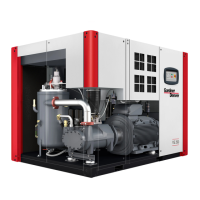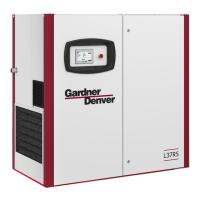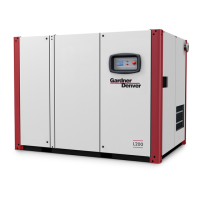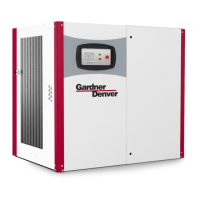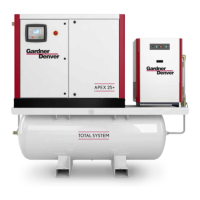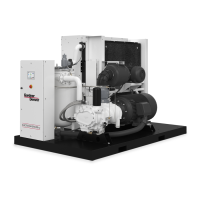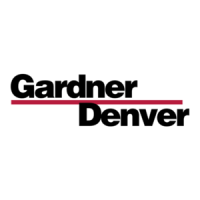
Do you have a question about the Gardner Denver Champion ROTORCHAMP EFD99A and is the answer not in the manual?
| Brand | Gardner Denver |
|---|---|
| Model | Champion ROTORCHAMP EFD99A |
| Category | Air Compressor |
| Language | English |
Defines hazard level indicating severe personal injury, death, or property damage.
Defines hazard level indicating severe personal injury, death, or property damage.
Defines hazard level indicating minor personal injury or property damage.
Notifies important information that is not hazard-related.
Describes the rotary screw compressor as a single-stage, positive displacement rotary machine.
Explains the process of air compression via meshing helical rotors.
Details the path of air through the compressor system.
Explains how oil is used for compressor lubrication, cooling, and sealing.
Critical warnings for severe injury or death if ignored.
Important warnings for severe injury, death, or property damage.
Visual warnings for hazards like discharge air, pressure, and modification.
Visual warnings for rotating machinery and automatic restart hazards.
Initial checks and reporting of damage upon unit receipt.
Proper methods to prevent damage and injury during lifting operations.
Guidelines for selecting an optimal installation site.
Details on airflow requirements and cooler core maintenance.
Recommendations for mounting the compressor on a stable surface.
Information on the location of the oil reservoir drain point.
Details on accessing panels and importance of closed doors for operation.
Warning against operating the unit with guards or panels removed.
Precautions for operating in temperatures down to +10° F.
Specifications for the compressor inlet line construction.
Details on connecting the discharge service line and valve usage.
Guidance on performing electrical wiring according to codes by qualified electricians.
Mandatory grounding procedures according to electrical codes.
Step-by-step guide for regreasing motor bearings.
Lists recommended grease manufacturers and trade names.
Provides relubrication intervals based on service conditions.
Essential checks before initial unit operation.
Steps for starting the compressor, including oil and air checks.
Procedure to check correct motor rotation direction.
Guidance on setting system pressure within nameplate limits.
Ensuring panels and doors are closed and latched.
Steps for starting the unit when cold.
Steps for starting the unit when hot.
Procedure for safely shutting down the compressor.
Overview of the prewired controls, motor, and starter.
Explanation of the Auto Sentry control system's operation modes.
Describes the Auto Sentry controller's integration of functions.
Details on the relief valve's purpose, testing, and safety.
Details on oil level gauge, pressure valves, inlet/unloader valves, check, blowdown, purge valves, transducers, and switches.
Details on discharge/reservoir thermistors, emergency stop, control transformer, terminal strip, and main starter.
Procedure for changing seals in the minimum pressure/check valve.
Explains the flow of oil through the cooler, filter, and compressor.
Details Champion's recommended lubricants and availability.
Information on Champion RotorLub 4000 Lubricating Coolant.
Recommends RotorLub 8000 for sustained high temperatures.
References installation guidelines for cold environments.
Step-by-step guide to checking and adding oil.
Chart showing recommended oil change intervals by discharge temperature.
Steps for safely draining the complete oil system.
Steps for safely filling the oil reservoir.
Primary steps for upgrading or changing lubricant type.
Instructions for replacing the standard duty air filter element.
Guidance on filter element replacement criteria and care.
Details on oil cooler, thermostatic valve, oil reservoir, air/oil separator, and pressure differential monitoring.
Step-by-step guide for removing and replacing the oil separator.
Procedures for checking oil discharge, inlet temperatures, and pressures.
Procedure for removing and installing new drive belts.
Procedure for replacing the compressor sheave.
Detailed steps for achieving proper parallel and angular sheave alignment.
Methods and tools for checking and adjusting belt tension.
Summary of maintenance actions based on operating hours.
Details on daily, 125, 1000, 4000 hour, and yearly maintenance.
Addresses issues with starting, stopping, loading, and unloading.
Troubleshoots excessive cycling and unloaded operation.
Diagnoses issues like slow starts, low pressure, high temps, and excessive oil usage.
Identifies causes of oil carryover and their solutions.
Explains how operating voltages affect compressor components.
Details symptoms related to high or low voltage conditions.
Outlines general limitations and conditions for warranty claims.
Specifies warranty durations for different compressor components.
States the exclusivity of warranties and limitations of liability.



